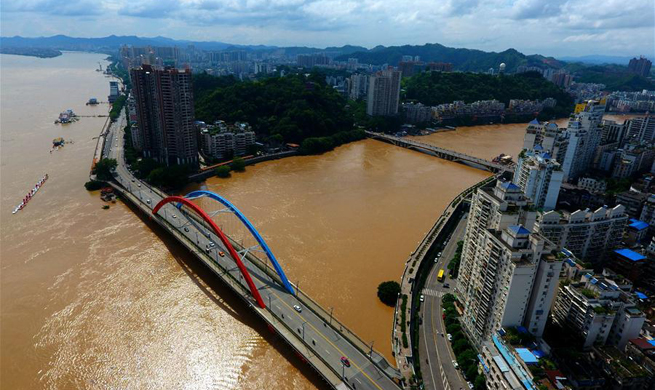By Xinhua writer Yu Fei
CHENGDU, July 5 (Xinhua) -- Breathtaking scenery and breathtaking dangers -- both will face Chinese engineers as they embark on building the world's most difficult railway.
The Sichuan-Tibet Railway will be the second railway into southwest China's Tibet Autonomous Region after the Qinghai-Tibet Railway. The line will go through the southeast of the Qinghai-Tibet Plateau, one of the world's most geologically active areas.
"The construction and operation of the Sichuan-Tibet Railway must overcome the biggest risks in the world," said You Yong, chief engineer of the Institute of Mountain Hazards and Environment of the Chinese Academy of Sciences (CAS), who is leading a scientific and technological support team to avoid disasters in the mountains.
China Railway Eryuan Engineering Group Co. Ltd., which is designing the line, said it will run from Chengdu, capital of southwest China's Sichuan Province, through Ya'an and Kangding, and enter Tibet via Qamdo. It will then go through Nyingchi and Shannan prefectures before arriving at Lhasa, capital of Tibet. The total construction length will be about 1,700 kilometers and it will cost 250 billion yuan (about 36.88 billion U.S. dollars)
EPIC JOURNEY
Already dubbed an epic journey, the Sichuan-Tibet Railway is a key project for China's 13th Five-Year Plan from 2016 to 2020. It will climb from the Sichuan Basin several hundred meters above sea level to the "Roof of the World", at an altitude of more than 4,400 meters.
Xia Lie, a senior engineer at China Railway Eryuan Engineering Group, described it as a huge "roller coaster" through risky terrain of mountains and canyons.
It will go through eight ascents and descents, and more than 80 percent of the line will be tunnels and bridges.
"The cumulative ascent of the Sichuan-Tibet Railway will exceed 16,000 meters, which is equivalent to double the height of Qomolangma, the world' s highest mountain," said Xia.
"It will be the most difficult super project in railway construction history."
Construction has begun on the two ends of the railway. The section between Chengdu and Ya'an is expected to open in June 2018. The feasibility study on the section between Ya'an and Kangding has been completed. The section between Lhasa and Nyingchi is under construction.
However, the section from Kangding to Nyingchi -- the most difficult and the longest section -- is still under design. Its construction is expected to begin in 2019 and could take about seven years, said Xia.
The Sichuan-Tibet Railway will be a major line in the western China rail network, connecting Tibet and more developed central and eastern regions. The design speed is from 160 kilometers per hour to 200 kilometers per hour. On completion, the travel time by train from Chengdu to Lhasa will be cut from 48 hours to about 13 hours.
Xia said experts conducted a scientific study of the key technologies needed for the construction in May 2016. When the team arrived at a town in Tibet's Markam County, all the people turned out to present them with hada, pieces of silk given as greetings, and buttered tea, and expressed the wish to see the railway built as early as possible.
BEAUTIFUL BUT DANGEROUS
White snow capped mountains, crystal glaciers, steep mountains, deep canyons, dense forests, green grasslands, clear lakes, and swift rivers...
The Sichuan-Tibet Railway will string together many beautiful vistas -- but with hidden dangers.
You Yong, who has spent almost 30 years studying mountain hazards, said the line will traverse the eastern Qinghai-Tibet Plateau, which has sharp changes in terrain.
It will go over 21 snow-capped mountains more than 4,000 meters high and cross 14 major rivers. The region is full of steep slopes and deep valleys, You said.
The active geological structure of the region causes strong earthquakes. The railway will go through earthquake zones such as the Longmen Mountain and Yarlung Zangbo River seismic belts, You said.
The magnitude-8 earthquake that devastated Sichuan's Wenchuan County in 2008 caused great environmental changes and destroyed countless roads. The quake caused mountain hazards such as landslides and debris flows.
You said the Sichuan-Tibet Railway has four major environmental characteristics: significant terrain elevation differences, strong plate activities, frequent mountain disasters, and a sensitive ecological environment.
Mountain hazards were a major challenge. "The regions along the Sichuan-Tibet Railway have the most developed, most active, most diverse and most serious mountain hazards in China," You said.
For instance, there are 399 hazard sites in the region along the Parlung Zangbo River in Tibet, regarded as one of the most dangerous road sections in the world. The frequent hazards block roads and cause crashers.
Scientists point out that the dangers along the railway route include landslides, debris flows, and snow and ice damage. The landslides mainly happen in the alpine gorges of the Hengduan Mountains and southeastern Tibet.
The section in Tibet could suffer from the most concentrated, frequent and serious debris flows in China. The region has 341 large or medium-sized debris flow gullies.
Southeastern Tibet and western Sichuan have many glaciers, which are sensitive to global climate change. Melting ice and snow causes devastating bursts of glacier lakes and debris flows, said Chen Xiaoqing, deputy director of the Institute of Mountain Hazards and Environment of the CAS.
In July 1988, a burst glacier lake and debris flow swept away a village in Midui gully, in Tibet's Bomi County, and closed the road for half a year.
Another huge landslide and debris flow in the Zhamu Creek, Yigong in Bomi County, on April 9, 2000, destroyed all the bridges, roads and communication facilities built over the previous four decades in the lower region, causing direct economic losses of 300 million yuan and indirect losses of up to a billion yuan.
SCIENTISTS' CAUTION
"Constructing a railway in such a complicated geological environment will face a lot of scientific and technological difficulties. And the prevention and control of mountain hazards will be key to its success," said You.
On the other hand, a large construction project traversing the region might aggravate the risks of mountain disasters and endanger the project itself.
"We must urgently master the distribution pattern of landslides, debris flows and other mountain hazards, and their influence on the railway project. We need to demarcate safe and dangerous areas, and study how to forecast and prevent disasters," You said.
The CAS began in 2014 to analyze the mountain hazard distribution patterns and risks, and experiment on disaster prevention along the route.
To date, scientists have identified the basic distribution and activities of mountain hazards, and set up a data bank for the hazards along the route.
Based on analysis of the risks, researchers offered their advice on the route selection and technologies to prevent and control the landslides and debris flows.
The government is also planning to build an expressway connecting Sichuan and Tibet. The scientific findings will also be applied in that construction.
Experts say the railway and expressway will push forward the opening up and economic development of Tibet.

















